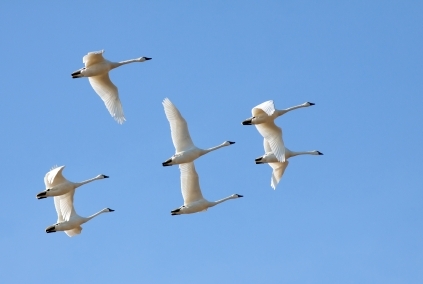Tundra swan migration: a natural spectacle
Michigan Department of Natural Resources sent this bulletin at 11/30/2012 12:23 PM ESTWildlife Viewing
Michigan wildlife viewers and enthusiasts,
Following is another in our series of stories about Michigan’s unique and wonderful wildlife species. Enjoy!
Migration Day
by Doug Reeves, assistant chief, DNR Wildlife Division
 Nov. 12, 2012 was the Veteran’s Day holiday but it was also a spectacular migration day. A strong cold front came across the continent, with the northern portion arriving in Mid-Michigan during the early morning hours accompanied by rain. The rain had ended by about noon, and the temperature dropped from the low 50’s to the upper 30’s. There was a strong westerly wind, sometimes with significant shifts to the north or northwest. Conditions were just right for tundra swans to migrate, and migrate they did! I wish I knew how many flew overhead within earshot of me that afternoon. I was outside much of the day, and I saw the first flock at about 11:30. From then until nearly dark, there were only a few minutes when I could not hear or see tundra swans. Flocks varying in size from about a dozen to nearly 80 flew all afternoon. It was truly spectacular.
Nov. 12, 2012 was the Veteran’s Day holiday but it was also a spectacular migration day. A strong cold front came across the continent, with the northern portion arriving in Mid-Michigan during the early morning hours accompanied by rain. The rain had ended by about noon, and the temperature dropped from the low 50’s to the upper 30’s. There was a strong westerly wind, sometimes with significant shifts to the north or northwest. Conditions were just right for tundra swans to migrate, and migrate they did! I wish I knew how many flew overhead within earshot of me that afternoon. I was outside much of the day, and I saw the first flock at about 11:30. From then until nearly dark, there were only a few minutes when I could not hear or see tundra swans. Flocks varying in size from about a dozen to nearly 80 flew all afternoon. It was truly spectacular.
The autumn tundra swan migration route takes many of these birds diagonally across North America. One of the most substantial breeding areas for tundra swans is in western Alaska. Many of those birds migrate southeast all the way to the Atlantic coast, where they spend the winter from Chesapeake Bay south to about the northern border of Georgia. That route takes them directly over central Michigan, where thousands stop over on Saginaw Bay before resuming the journey when things get cold enough and the weather again sends them to their wintering grounds. A quick call to the Fish Point Wildlife Area on Nov. 13 confirmed that there were at least 3,000 tundra swans that had arrived in the area the previous afternoon. The temperatures on the national weather map told the story. In North Dakota things were freezing up, as temperature readings were in the upper teens. In Minnesota and parts of Wisconsin, thermometers reported readings in the 20’s. Strong westerly winds meant once the birds were aloft, they didn’t have to expend a lot of energy to fly long distances. That was evident, because many of the birds glided at least part of the distance that I could see them. They were traveling at high rates of speed.
The call of migrating tundra swans is unmistakable and always makes me look up. It’s kind of a haunting ow-ooh-ow-oh that I hear, very distinct from the Canada geese and sandhill cranes that are also in the area at the time. Tundra swans are vocal birds too, seeming to call as much during their autumn migration as Canada geese do during spring.
Beginning about Nov. 1, I had anticipated hearing tundra swans. I have observed significant swan migrations as early as the Nov. 4-5 and as late as Thanksgiving weekend. When the first flock came into earshot on Nov. 12, I stopped what I was doing, looked up and watched from when I could first see the birds until they were out of sight. I wondered if they had seen moose last week and whether their most recent stop had been somewhere in Wisconsin, Minnesota or even North Dakota. I recalled times in the past when the sun had shone on swan wings and flashed a brilliant white, almost silver, color. A flock of sunlit tundra swans flying in the V formation is a beautiful sight, especially if the background is a cloudy sky and the sun is coming from an open hole in the clouds.
I have come to think of tundra swans as the bringers of winter. They migrate overhead just before things turn very cold and snow starts to appear. Sure enough, on the morning of Nov. 13, the top and windshield of the car were snow-covered. Soon the ponds will be covered with ice. But the swans will return again in March. At some point shortly after ice-out, several thousand will stop over at Saginaw Bay on their way back northwest. You might want to make a visit to the east side of the bay about then to see and hear a true natural spectacle.
Learn more about the tundra swan.
Show your support for conserving wildlife habitat in Michigan by purchasing the wildlife habitat license plate!

